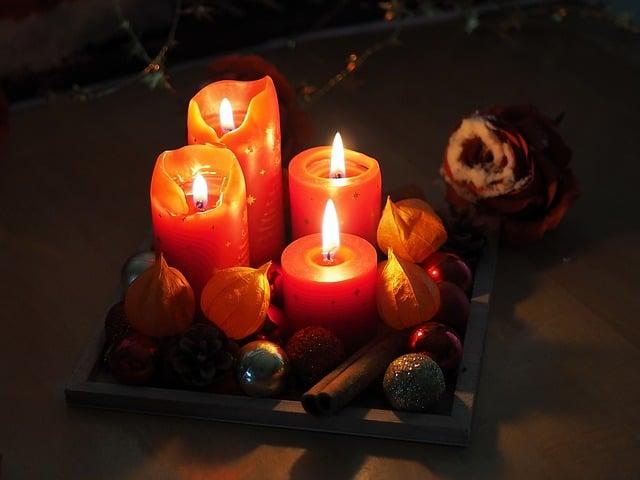In the early 19th century, a mother in Germany sought a way to make the days leading up to Christmas more special for her children. She crafted a simple calendar, marking each day of December with a chalk line on the door. As the days passed, the children eagerly erased a line, counting down to Christmas with excitement. Inspired by this tradition, a local printer began creating colorful cards with doors to open, each revealing a small image or verse. Thus, the Advent calendar was born, transforming anticipation into a cherished holiday ritual.
Table of Contents
- The Historical Origins of the Advent Calendar
- Cultural Significance and Evolution Through the Ages
- Modern Interpretations and Creative Variations
- Tips for Crafting Your Own Personalized Advent Calendar
- Q&A

The Historical Origins of the Advent Calendar
The Advent calendar, a cherished tradition in many households, has its roots in the early 19th century. It is believed that the first Advent calendars were created in Germany, where families would mark the days of Advent leading up to Christmas with chalk on doors or by lighting candles. This practice evolved into the creation of handmade calendars, often adorned with religious imagery and symbols. These early versions served not only as a countdown to Christmas but also as a way to engage children in the anticipation of the holiday season.
By the early 20th century, the Advent calendar began to take on a more commercial form. The first printed Advent calendar is credited to a German publisher named Gerhard Lang, who produced a calendar in 1908 featuring small doors that could be opened to reveal images or messages. This innovation sparked a wave of creativity, leading to the diverse and colorful designs we see today. Advent calendars have since transformed into a delightful blend of tradition and modernity, often filled with chocolates, toys, or personalized surprises, while still retaining their original purpose of marking the days until Christmas.

Cultural Significance and Evolution Through the Ages
The Advent calendar, a cherished tradition in many households, has evolved significantly since its inception in the 19th century. Originally, it served as a simple countdown to Christmas, with early versions featuring chalk marks on doors or the lighting of candles. As the years progressed, the concept transformed into a more elaborate form, incorporating small doors that revealed images or scriptures, reflecting the religious significance of the season. This evolution not only marked the passage of time but also deepened the connection to the spiritual anticipation of Christmas, making it a meaningful ritual for families.
In contemporary society, the Advent calendar has transcended its religious roots, embracing a broader cultural significance. Today, it is often filled with a variety of surprises, from chocolates to toys, appealing to children and adults alike. This shift highlights a growing trend of personalization and creativity, as individuals and brands craft unique calendars that resonate with diverse interests. The Advent calendar now serves as a symbol of joy and excitement, fostering a sense of community and shared experience during the festive season. Its journey through the ages reflects not only changes in societal values but also the enduring human desire to celebrate and connect during this special time of year.

Modern Interpretations and Creative Variations
In recent years, the Advent calendar has evolved far beyond its traditional roots, inspiring a plethora of modern interpretations that cater to diverse interests and age groups. Today, you can find Advent calendars filled with an array of surprises, from gourmet chocolates and artisanal teas to beauty products and craft supplies. This creative expansion has transformed the calendar into a personalized experience, allowing individuals to curate their own countdown to Christmas. Some popular variations include:
- DIY Advent Calendars: Craft enthusiasts often create their own calendars, using materials like paper, fabric, or wood, to add a personal touch.
- Experience Calendars: Instead of physical gifts, these calendars offer daily activities or experiences, such as family outings or acts of kindness.
- Pet Advent Calendars: Catering to furry friends, these calendars are filled with treats and toys designed specifically for pets.
- Charity Calendars: Some calendars focus on giving back, with each day dedicated to a different charitable cause or donation opportunity.
Moreover, the digital age has ushered in a new wave of virtual Advent calendars, where users can unlock daily surprises online. These can range from exclusive content, such as recipes or holiday tips, to interactive games and challenges that engage users in the festive spirit. The flexibility of the Advent calendar format allows for endless creativity, making it a beloved tradition that continues to adapt and thrive in contemporary culture. As people seek unique ways to celebrate the season, the Advent calendar remains a cherished symbol of anticipation and joy, reflecting the diverse tapestry of modern holiday traditions.

Tips for Crafting Your Own Personalized Advent Calendar
Creating a personalized Advent calendar is a delightful way to count down to the festive season, and it allows you to infuse your unique style into each day. Start by selecting a theme that resonates with you or your loved ones—this could be anything from favorite holiday treats to cherished memories. Gather materials such as small boxes, envelopes, or even cloth bags, and consider using decorative paper or fabric to wrap each item. **Incorporate elements like:**
- Handwritten notes with daily affirmations or holiday quotes
- Small gifts like candies, trinkets, or beauty products
- Activities to do together, such as baking cookies or watching a holiday movie
Next, think about the layout of your calendar. You can create a wall hanging, a table centerpiece, or even a digital version if you prefer a tech-savvy approach. **Make it visually appealing by:**
- Using a color scheme that matches your holiday decor
- Incorporating natural elements like pinecones or dried oranges
- Adding personal touches, such as family photos or handmade ornaments
By blending creativity with personal significance, your Advent calendar will not only serve as a countdown but also as a cherished keepsake that brings joy throughout the holiday season.
Q&A
-
Who invented the Advent calendar?
The Advent calendar as we know it today was popularized in the 19th century, but its origins can be traced back to German Lutherans in the early 1800s. The first known Advent calendar was created in 1908 by a woman named Gerhard Lang.
-
What was the original purpose of the Advent calendar?
The original purpose of the Advent calendar was to help families count down the days until Christmas, marking the anticipation of the holiday season. It served as a visual reminder of the days leading up to the celebration of Christ’s birth.
-
How has the Advent calendar evolved over time?
Initially, Advent calendars were simple, often featuring chalk marks or candles. Today, they come in various forms, including chocolate-filled doors, toys, and even beauty products, reflecting a broader range of themes and interests.
-
Are Advent calendars used only in Christian traditions?
While Advent calendars originated in Christian traditions, their popularity has spread beyond religious contexts. Many people now enjoy them as a fun way to celebrate the holiday season, regardless of their religious beliefs.
As we close the door on the history of the Advent calendar, we uncover a tapestry woven with tradition and innovation. From humble beginnings to a cherished holiday staple, its journey reflects the spirit of anticipation that unites us all.




